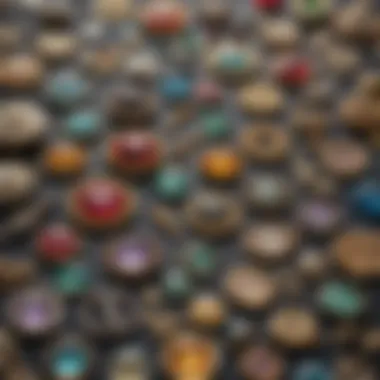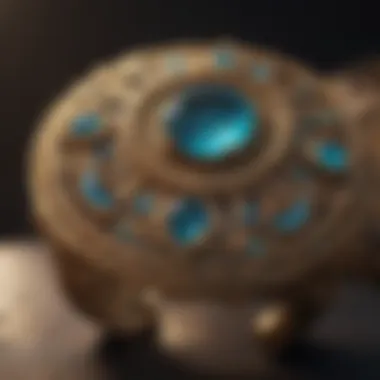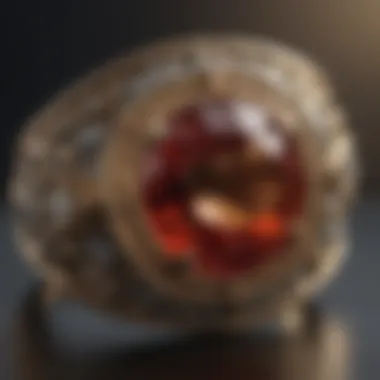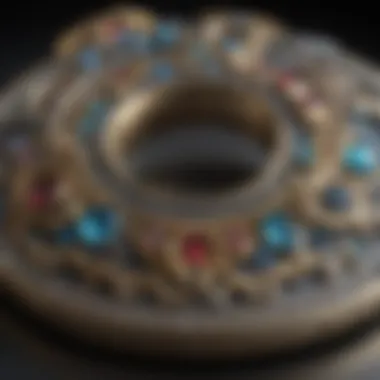Best Jewelry Adhesive: Essential Guide for Collectors


Intro
Selecting the right adhesive is crucial in preserving the integrity of any jewelry piece. For collectors and hobbyists, understanding specific types of jewelry adhesives can enhance restoration projects significantly. This guide lays the foundation for choosing adhesives suited to various materials and outlines practical application techniques and troubleshooting suggestions.
Effective use of jewelry adhesive goes beyond simple bond formation; it requires knowledge of materials, conditions, and potential challenges. Collectors often encounter situations that necessitate repairs or refurbishing, making familiarity with adhesive options important. In what follows, we will explore the characteristics that define an ideal adhesive, along with critical insights into application techniques.
Types of Jewelry Adhesive
Adhesives come in different types, each having distinct properties suitable for specific uses. Here are the common types you may encounter:
- Cyanoacrylate: Commonly known as super glue, this adhesive provides a strong bond and surfaces often set quickly. While useful for minor repairs, it is less flexible once cured and not ideal for paper or porous materials.
- Epoxy: This two-part adhesive is highly versatile, often providing a strong, waterproof bond suitable for various materials, including metals, stones, and glass. It’s particularly effective for jewelry that experiences varying levels of stress.
- Polyurethane: Noted for its flexibility, polyurethane is also waterproof and cures to create a durable bond. It is good for materials that may expand or contract and for mixed materials.
- Craft Glue: While useful for straighforward bonding, it may lack the strong bond required for high-quality jewelry. It is more suitable for decorative applications.
Understanding your project’s specifics enables informed decisions regarding which adhesive to select.
Application Techniques
While choosing the right adhesive is important, how you apply it can greatly affect the outcome. Here are some tips to ensure effective application:
- Clean Surfaces: Ensure that surfaces are free of dust or oils; they can severely impact the bond's effectiveness.
- Use a Small Amount: A little adhesive goes a long way. Using too much may ooze out and affect the piece negatively.
- Follow Instructions: The mixing ratios, drying times, and application methods are crucial, especially for multi-part adhesives like epoxy.
- Utilize Clamps: For stronger bonds, sometimes holding items in place can help. A gentle pressure helps create a better bond as the adhesive sets.
- Be Patient: Allow adequate time for curing. Some glues need time beyond just mere drying to form a strong bond.
Always read the adhesive's instruction before application for best results.
Common Issues and Troubleshooting
Even the most experienced collectors face challenges when working with adhesives. Here are issues that may arise and how to solve them:
- Delayed Curing: If the adhesive is not setting properly, check the environment. Humidity and temperature can significantly impact curing times.
- Poor Bond: This could stem from insufficient cleaning before application—ensure surfaces are clear and dry.
- Yellowing: If clear adhesives turn yellow over time, especially UV exposure, consider using UV-resistant models in future projects.
- Breaks post-repair: Going overly quick with repairs before fully tested strength can lead to repeated damage. Patience aids durability.
Prologue to Jewelry Adhesives
Jewelry adhesives serve as a cornerstone in both crafting and restoring intricate pieces of art. Understanding which adhesive to use can significantly influence the longevity and aesthetic of a creation. Collectors and hobbyists alike often encounter situations where stones may come loose or delicate connections break. Having knowledge about appropriate adhesives becomes essential. This article examines the purpose and importance of jewelry adhesives with an aim to offer understanding and guidance to enthusiasts.
Purpose and Importance
Jewelry repairs are not merely functional but also preserve the beauty of the piece. The primary purpose of a good adhesive is to form a durable bond between materials without adversely affecting the visual appeal. Soudly selecting an effective adhesive can also ensure that repairs withstand the test of time and characteristic wear. Additionally, many collectors value the holistic approach of using suitable adhesives, as it aligns with the meticulous nature of their craft. This segment will outline the practical considerations and skillful approaches to applying adhesives in jewelry, addressing the meanings behind surfaces, weight, and environment. Comprehensive understanding here bolsters the collector’s toolkit.
Understanding Adhesive Types
Adhesive types cater to diverse needs and materials present in jewelry making. Various bonds are created depending on the adhesive's formulation. Jewelers often experiment to find the right match required. Here are a few common adhesive types and their unique properties:
- Epoxy Adhesives: Known for creating strong, lasting bonds. They come in two-part formulas that cure extended exposure to air.
- Super Glue Variants: Offers rapid adhesion, making it easy for small repairs. However, some variants may be brittle one cured.
- Polyurethane Adhesives: They are known for being flexible. Particularly suited for materials exposed to varying conditions.
Understanding different types of adhesives enables collectors to identify the right product match for their specific requirements when tackling jewelry repair or making. Overall, thoughtful use of adhesives should reflect the intricacies of the field and products being worked with.
Types of Jewelry Adhesives
Understanding the types of jewelry adhesives is crucial for anyone interested in the craft of jewelry making and repair. The selection of the right adhesive influences the strength of the bond, the durability of the finished piece, and the overall satisfaction with the result. Each type brings its own characteristics, benefits, and considerations regarding compatibility with different materials.
This section will categorize these adhesives to give collectors a comprehensive understanding. By knowing these options, you can make informed decisions that suit your specific project demands and the materials you are working with.


Epoxy Adhesives
Epoxy adhesive is a two-part system that provides a strong and durable bond. It consists of a resin and a hardener that, when mixed, create a tough, solid glue. It is particularly popular among jewelry makers because of its versatility and exceptional holding strength. Epoxy adhesives can bond various materials, including metal, plastic, glass, and stone.
When using epoxy, it is essential to pay attention to the curing time, which can vary from a few minutes to several hours based on the formulation. This type of adhesive is ideal for intricate jewelry repairs, as it fills gaps and works well on surfaces that may be difficult to join with other substances. The finished bond is often quite clear, making it easier to use in aesthetic crafts.
Super Glue Variants
Super glue, or cyanoacrylate adhesive, is another common type in jewelry making. It provides quick bonding and strong adhesion, which makes it suitable for parts that require an immediate fix. However, the strengths of super glue can also be its weaknesses, as it tends to be brittle when fully cured, making it less suitable for flexible applications.
Different formulations of super glue exist, some designed specifically for certain materials. This is effective for small repairs and working with beads or components that need to be temporarily joined. Nevertheless, users must handle the adhesive carefully due to its fast-drying nature. If you have not included all existing options, keep in mind how the chosen one will handle under stress during their use.
Polyurethane Adhesives
Polyurethane adhesives are particularly useful when flexible bonding is required. This adhesive does better on porous materials compared to other types like epoxy or super glue. Polyurethane creates a bond that is resistant to moisture and temperature changes, offering a significant advantage in certain situations. Its ability to expand and contract means it can tolerate movement better than its counterparts.
One critical consideration is that polyurethane adhesive typically takes longer to cure fully. Users may need to clamp items for longer periods compared to epoxy or super glue, which could affect project timelines. Despite the longer drying time, polyurethanes work exceptionally well on multifaceted materials including wood, metal, and some plastics.
Specialty Jewelry Adhesives
Specialty jewelry adhesives are crafted with particular needs in mind. They target specific materials or bond styles unique to jewelry projects. For instance, there are adhesives tailored for semi-precious stones, beads, or certain metals to ensure compatibility in color and texture.
Consultation with product descriptions is necessary to find these options, as they offer unique properties that general adhesives may not have. It's also worthy to note such adhesives might provide additional benefits, such as UV resistance or enhanced clarity, that can lend them significant advantages for collectors. Being aware of these niche products can elevate your crafting process, enhancing the outcome.
Selecting the right adhesive is integral to successful jewelry repair or creation. Each type has varying strengths and weaknesses that you must prioritize based on the materials and specific requirements of your projects.
Choosing an adhesive should never be a hurried decision but rather a considered one, reflecting on project specifications.
Criteria for Selecting Jewelry Adhesive
Selecting the right jewelry adhesive is crucial for both functional and aesthetic outcomes. Each adhesive has specific properties that make it suitable or unsuitable for various materials and applications. Understanding the criteria for selecting suitable adhesives ensures that collectors and hobbyists can effectively maintain the integrity of their jewelry pieces and achieve lasting repairs. Consider the following essential elements when choosing an adhesive.
Material Compatibility
Material compatibility should be the first consideration when selecting a jewelry adhesive. Not all adhesives work well with every material. A glue that adheres perfectly to metal might struggle with gemstones or plastics.
- Resin-based adhesives are generally suitable for glass, making them ideal for items like beaded bracelets.
- Cyanoacrylate glues, commonly known as super glues, work well for metal origami creations but can damage delicate gemstones.
- Two-part epoxy, known for its versatility, can bond dissimilar materials effectively. It is often used in crafts, repairs, and creating complex jewelry pieces.
Ensuring that the adhesive you plan to use matches the materials in your project is essential to achieving the desired results and preventing future issues.
Durability and Flexibility
Durability is another critical factor in selecting jewelry adhesive. A permanent bond is necessary for most jewelry types, but flexibility is equally important, especially for pieces that experience motion, such as bracelets.
- Epoxy adhesives provide a strong bond that can withstand various stress levels while maintaining some flexibility.
- Polyurethane adhesives are also flexible once cured, making them suitable for items that may undergo bending or twisting.
- In contrast, rapid-drying cyanoacrylates can sometimes become brittle over time, risking bond failure on joints that require a more dynamic attachment.
Choices will often depend on the wear and tear expected in the jewelry. Pieces that will be regularly worn need a more robust adhesive.
Drying Time and Clarity


Drying time and clarity of the adhesive are two additional elements worth scrutinizing. While a swift drying time can be beneficial for quick fixes, it may impede effective application, especially on more intricate pieces.
- Some enjoy using slow-drying epoxies, as they allow more time for alignment before they cure, reducing hassle.
- For visibility, users frequently prefer adhesives that dry clear, as their transparency does not affect the appearance of the jewelry. However, certain epoxy and polyurethane adhesives can dry with a tint.
Take the time to check the specifications regarding drying time and clarity before purchasing. This will ensure that your adhesive choice aligns with your needs and projects specifications to avoid mishaps.
When it comes to ensuring the longevity of your jewelry repairs, material compatibility, durability, flexibility, and drying processes are key elements that can define your success in crafting.
Application Techniques
Applying jewelry adhesives effectively is essential for achieving strong and lasting bonds. Improper application can lead to various issues, including weak joins and unsightly messes. This section discusses the fundamental aspects of applying jewelry adhesives ranging from preparation surfaces to the curing process. Understanding these techniques ensures successful repairs and enhances the longevity of the jewelry pieces.
Surface Preparation
The groundwork for any successful adhesive application starts with surface preparation. Ignoring this step often leads to inadequate adhesion. Each material requires unique treatment methods before applying the adhesive. For instance, both metal and clay objects benefit from cleaning to ensure all dirt and residues are eliminated. This can typically be done using isopropyl alcohol or a mild soap solution.
It is also crucial to dry the surfaces completely after cleaning. Moisture can significantly reduce the bond strength. Moreover, the surface texture plays a role; roughening smooth surfaces with fine sandpaper grants more surface area for the adhesive to grip. Thus, proper surface preparation makes a significant difference in adhesion quality and durability.
Applying the Adhesive Properly
The correct application of adhesive is often a deciding factor in the success of your project. Adhere to the following approaches:
- Use the right amount: A small amount of adhesive usually goes a long way. Too much can cause overflow; too little may not be enough to secure the pieces reliably.
- Controlled application: Consider using a fine-tipped applicator for precise control. This ensures that the adhesive flows exactly where it is needed without excess.
- Even spreading: It's beneficial to spread the adhesive evenly. For specific types like epoxy, mixing components thoroughly before application is essential. Follow the manufacturer’s instructions for optimal results.
Achieving an even coating will prevent gaps and ensure stronger bonds between the surfaces. Working quickly without rush but maintaining efficiency helps, since some adhesives have a limited work time before they start to cure.
Clamp and Cure Time
After applying the adhesive, a phase of clamping and curing is critical. Effective clamping creates pressure between the joint surfaces, which increases the bond’s strength and accelerates curing. The optimal clamping time varies depending on the adhesive used. For instance, epoxies may require more time due to their formula which hardens through epoxy interaction.
General steps to remember during this phase:
- Immediate clamping: As soon as the adhesive is applied, clamp the pieces together. This ensures control while the adhesive begins to set.
- Follow instructions: Always defer to manufacturer guidelines for exact curing times. Adhering to these specifications progresses between lightweight adherence and full structural strength.
- Allow adequate time: Insufficient curing time can lead to premature failure of the repair.
Properly applied jewelry adhesive with guided curing improves the overall performance of bonds, benefiting the durability and attractiveness of jewelry repairs.
In essence, mastering application techniques transforms a functional adhesive into a robust solution. Relying on well-executed surface preparation, appropriate adhesive application, and patient curing ensures jewelry retains its aesthetic and functional integrity over time.
Common Issues with Jewelry Adhesives
When engaging with jewelry adhesives, users often face common issues that can affect their repair projects. Understanding these issues is essential for collectors, as knowing how to prevent or resolve them can save time, resources, and effort. The following sections examine critical problems: bond failure, cloudiness in adhesive, and debonding concerns.
Bond Failure
Bond failure is a primary complication when using jewelry adhesives. This occurs when the adhesive does not create a strong enough bond between materials. Such failures can stem from various factors.
- Surface contamination: If there's dust, oil, or other residues, the adhesive may not adhere correctly.
- Incompatibility: Not all adhesives work well with every material; choosing the wrong type can lead to a failed bond.
- Insufficient curing time: Rushing the adhesion process might mean the bond hasn't set properly, causing it to break easily.
To reduce the risk of bond failure, users should ensure the surfaces are clean and dry. Ket's stress the importance of patience in allowing pieces to cure completely before handling them again.


Cloudiness in Adhesive
Another common issue lies in cloudiness of adhesive after it dries. This is particularly troubling for clear or transparent jewelry, where such imperfections can degrade aesthetics substantially. The main reasons for cloudiness include:
- Moisture in the environment during curing.
- Over-application of the adhesive, resulting in a thick layer that won't dry transparently.
- Contamination from other materials introduced during application.
To minimize cloudiness, users should apply thin layers and much environmental control directing the curing process in dry conditions. Regular monitoring of the adhesive as it cures can also help identify and correct problems before they arise.
Debonding Concerns
Debonding often manifests as a gradual loss of adhesion after a visible bond seems secure. Several factors might lead to debonding:
- Changes in temperature or humidity: Extremes can affect various adhesives, weakening the bond.
- Mechanical stress: Frequent movement of joints in jewelry can gradually work against the adhesive.
- Chemical exposure: Certain cleaning products or environmental factors may lessen bond integrity over time.
To tackle debonding issues responsibly, collectors are advised to choose the right adhesive with the appropriate bond strength for their project. Regular care and examining pieces, noticing how the material appears with time, can help avert significant problems.
Understanding common issues with jewelry adhesives is vital for collectors. Knowing what can go wrong helps in making informed choices and leads to successful repairs, producing lasting and presentable items rather than frequent disappointments.
Troubleshooting Tips
Addressing issues that may arise during jewelry repairs is critical. Understanding how to troubleshoot can significantly enhance the experience for both novice and seasoned collectors. This section provides guidance on assessing bond integrity and effective cleaning methods to ensure lasting durability of repaired items.
Assessing Bond Integrity
The strength of the bond formed by adhesive is essential for the longevity of a jewelry repair. Assessing bond integrity involves careful inspection after the adhesive has cured. Key factors include:
- Visual Inspection: Check for any visible gaps or cracks at the junctions of the bonded materials.
- Physical Testing: Gently twist or pull on the bonded areas to gauge the strength of the adherent holding. A solid bond should not give under light pressure.
- Environmental Factors: Consider the conditions that the jewelry will face, such as exposure to moisture or temperature fluctuations. Curing conditions directly influence bond strength.
Remember to allow the adhesive to fully cure as per manufacturer instructions prior to testing.
A proper evaluation of the bond's integrity is fundamental; undetected weaknesses may lead to future repairs and deterioration.
Effective Cleaning Methods
Clean surfaces prior to applying an adhesive. Residual dirt, oil, or previous adhesive can hinder the bonding process. Here are some effective cleaning methods:
- Soap and Water: For most materials, warm soapy water works well. Use a soft brush to scrub without scratching the surface. Rinse thoroughly and dry completely.
- Isopropyl Alcohol: This is particularly effective for metals and certain plastics. It removed residues without leaving harmful oils behind.
- Professional Cleaners: For delicate items, commercial jewelry cleaners that pose no risk to the material may be used. Always verify that such products are suitable for the specific materials being cleaned.
Beyond cleaning, ensure that replacement loose pieces or parts are also prepared properly. The cleaning stage is crucial, as poorly cleaned sections may lead to inadequate bonding, hence making repair futile.
Finally, investing time in proper assessment and cleaning can yield good results in craft and restoration projects. A solid foundation helps ensure long-lasting repairs.
Finale
In the realm of jewelry making and restoration, the selection of adhesives emerges as a crucial consideration. Understanding the properties and challenges associated with various types of jewelry adhesives shapes your success in repairs or custom creations. Each adhesive has its advantages and limitations, necessitating careful evaluation based on material compatibility and desired durability.
Critical elements includes the drying time, clarity post-application, and flexibility of the bond. Missteps in adhesive choice could lead to bond failures or unwanted visual defects, making it vital for both novices and skilled artisans to assess options based on specific project needs. A clear grasp of application techniques also contributes significantly to successful jewelry repairs, as improper application can compromise integrity.
Emerging from all discussed principles is the paramount necessity for a meticulous approach, which will enhance the longevity of repairs and craftsmanship in jewelry. With the right adhesive and techniques, you can ensure your creations maintain their allure and functional integrity.
Final Recommendations
- Choose Appropriately: Base your adhesive choices on compatibility with materials. For instance, epoxy is often preferred for metals and some gems, while specialty formulas work better with specific materials.
- Test Before Use: Whenever possible, conduct a small test of the adhesive on a less noticeable area before commencing your primary repair. This will help understand how the adhesive will perform, particularly in terms of curing and clarity.
- Follow Application Guidelines: Make sure to read the instructions provided by manufacturers carefully. Adhering to recommended preparation steps and timing can play a pivotal role in bond effectiveness.
- Invest in Quality: It may be tempting to opt for cheaper options, but investing in high-quality products often translates to better performance and fewer issues in the long run. You may benefit from famous brands like E6000 or Gorilla Super Glue.
- Maintain Clean Workspace: Ensure your surfaces and materials are clean and well-prepared prior to application. Presence of dust or oils can lead to reducing bond effectiveness.
By closely heeding the advice in this comprehensive guide, you create solid foundations for achieving exceptional results in your jewelry projects. Understanding the specifics on practicing select adhesive types and mastering application techniques are your stepping stones to becoming proficient in jewelry crafting and repair.







